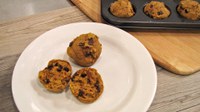Prairie Fare: Try These 4 Tips for Healthful Spring Celebrations
(Click an image below to view a high-resolution image that can be downloaded)
By Julie Garden-Robinson, Food and Nutrition Specialist
NDSU Extension Service
Here we go again in the Robinson household. Another child is all grown up and graduating from high school this year. I had a three-year break from the last child’s graduation, but the time flew by.
The other day, my daughter and I began making plans for the party with her godmother’s willing assistance. My 17-year-old daughter never has been “demanding,” so we had to coax her food wishes from her.
I have attended parties with meals ranging from root beer floats to pancakes and sausage to full-scale spaghetti and meatball dinners. My friends used to have “theme” parties and receptions, such as all white food, all red food or all round food. That brought out the creativity in people.
After our brainstorming session, my daughter was fine with the standard “afternoon fare” with some of her favorite items such as cheese and crackers, small sandwiches, salads and cupcakes, plus some veggies and fruits thrown in the mix. She wasn’t going to escape fruits and veggies. I’m not sure she realizes that she will be wearing an apron, helping us prepare the foods.
Celebrations often are exciting and memorable times filled with family, friends and food. Nourish your body every time you eat, whether you are celebrating a birthday, graduation, wedding shower, holiday or every day. Here are some tips and resources to help plan any size party:
- Incorporate at least three different food groups into celebration foods. MyPlate, the current dietary guidelines for Americans, includes five food groups: grains, vegetables, fruits, protein and dairy. When deciding on the menu, think how you can incorporate at least three of these food groups.
For example, make sandwiches with whole-grain breads or use whole-grain pasta in salads. Include a colorful vegetable tray on the menu. Consider having fruit parfaits instead of cake as a sweet treat. If you like cake, how about mini cupcakes or muffins, such as the recipe included with this column? Portion size matters.
If you decide to have a full-scale meal, be sure to use lean or extra-lean beef and poultry in sandwiches and casseroles. For snacks, consider serving hummus (made from protein-rich chickpeas) as a tasty dip with pita chips. See the NDSU Extension Service publication “Pinchin’ Pennies in the Kitchen: Hummus, Roasted Chickpeas and More” for savory and dessert hummus recipes (available at http://tinyurl.com/NDSU-hummus).
- Explore ingredient substitutions. You easily can trim calories and/or add fiber, vitamins and minerals with healthful swaps. For example, you can use fruit purees for one-half or more of the fat in baked products. You can substitute whole-wheat flour for half of the all-purpose flour in a recipe (2 cups of flour equals 1 cup of whole-wheat flour plus 1 cup of all-purpose flour). See the NDSU Extension Service publication “Now Serving: Recipe Makeovers” for many ideas (available at http://tinyurl.com/NDSU-recipemakeovers).
- Make food fun with a do-it-yourself meal. Get kids (and adults) involved in assembling their meal. For example, try setting up a buffet to make a “meal in a bowl” with rice, veggies, beans and other toppings. See the NDSU Extension Service publication “Pinchin’ Pennies in the Kitchen: 5 Steps to Making Your Own Meal in a Bowl” (available at http://tinyurl.com/NDSU-MealinaBowl).
- Remember to keep hot foods hot and cold foods cold. Hold cooked or reheated food above 140 F. Place the food in hot-holding equipment, such as chafing dishes, slow cookers and warming trays. Reheat previously prepared food to 165 F, using a stove, oven or microwave oven.
Keep cold foods at or below 40 F by nesting serving plates or bowls in containers of ice. To learn more about food-handling tips when cooking for a crowd, see the NDSU Extension Service publication “Cooking for Groups” (available at http://tinyurl.com/NDSU-CookforGroups).
Here’s a recipe we might try for my daughter’s graduation party. It was a big hit in taste testing on campus. Pumpkin is a nutrient-rich ingredient that is high in beta-carotene, which our body uses to produce vitamin A. Getting enough vitamin A in our diet helps keep our skin and eyes healthy.
Whole-wheat Mini Pumpkin Muffins
1 3/4 c. whole-wheat flour
1 tsp. baking powder
1 tsp. baking soda
1/2 tsp. salt
1 tsp. cinnamon
1 tsp. pumpkin pie spice
2 large eggs, room temperature
1/2 c. brown sugar, lightly packed
1 c. pumpkin puree
1/3 c. unsalted butter, melted
1 tsp. vanilla extract
1/3 c. milk
1/2 c. mini chocolate chips
Preheat oven to 350 F. Grease muffin tins; set aside. In a large bowl, whisk the flour, baking powder, baking soda, salt, cinnamon and pumpkin pie spice together; set aside. In another large bowl, whisk eggs, brown sugar, pumpkin, melted butter, vanilla and milk together until combined. Gradually add the dry ingredients to the wet ingredients. Stir to combine. Fold in mini chocolate chips. Fill muffin cups three-fourths full. Bake for 12 to 14 minutes or until a toothpick inserted in the center comes out clean. Cool slightly and serve.
Makes 36 servings. Each serving has 60 calories, 3 gram (g) fat, 1 g protein, 9 g carbohydrate, 1 g fiber and 90 milligrams sodium.
(Julie Garden-Robinson, Ph.D., R.D., L.R.D., is a North Dakota State University Extension Service food and nutrition specialist and professor in the Department of Health, Nutrition and Exercise Sciences.)
NDSU Agriculture Communication - April 21, 2016
| Source: | Julie Garden-Robinson, 701-231-7187, julie.garden-robinson@ndsu.edu |
|---|---|
| Editor: | Ellen Crawford, 701-231-5391, ellen.crawford@ndsu.edu |



